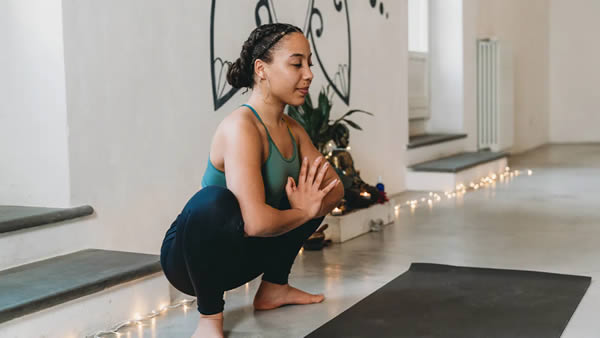
Kasia Gondek, PT, DPT, CSCS
What is endometriosis?
Endometriosis is a chronic gynecological condition that affects approximately 176 million women worldwide. Though it can occur at any age, it’s most common during a woman’s reproductive years, which are usually between ages 15 and 49.
If you’ve experienced endometriosis, you know how painful it can be. Part of managing endometriosis is managing the pelvic pain that usually accompanies the condition. Recent research has shown that yoga might be one way to do just that.
Yoga for endometriosis can ease symptoms and improve your overall well-being. It helps reduce pain, relieve tension, and encourage relaxation. Yoga can also help you manage stress and develop mindfulness.
Impact of yoga on endometriosis and pelvic pain
Living with endometriosis can affect your physical, mental, and emotional well-being.
Yoga offers several healing benefits that may help reduce endometriosis symptoms such as stress, tension, and pain.
It encourages relaxation, which helps relieve discomfort and calm your mind.
Research suggests yoga and breathing techniques are beneficial in alleviating pelvic pain in women with endometriosis.
In a small 2018 study, women who practiced yoga twice weekly for 8 weeks improved their introspective ability and mind-body connection, which had a positive effect on pain management.
In another small study, women who did yoga for endometriosis twice per week for 8 weeks had reduced chronic pelvic pain and improved quality of life.
According to Kasia Gondek, a physical therapist and certified strength and conditioning specialist, yoga helps manage endometriosis in several ways.
A yoga and mindfulness practice can improve breathing patterns, improve posture, and decrease pain from everyday activities,” she says. “It also helps to decrease and manage symptom flare-ups.”
Gondek, who specializes in women’s health and pelvic floor rehabilitation, recommends yoga styles that emphasize mindfulness, slow and controlled movement, and longer holding times. This includes gentle styles of yoga such as Hatha, yin, and restorative.
Gentle, restful poses help soften and relax the muscles around your pelvis, which helps create space and release tension.
To alleviate endometriosis pain and discomfort, Gondek advises focusing on restorative poses to release tension and promote relaxation. She explains,
Restorative positions encourage softening of the abdominals, low back muscles, inner thighs, pelvic floor muscles, and chest wall. These are the most common areas of the body to become tight and restricted.”
Risks of doing yoga for endometriosis
For the most part, it’s safe to practice yoga with endometriosis. Avoid vigorous styles of yoga such as Ashtanga, Vinyasa, or hot yoga since they can make symptoms worse. Listen to your body and stay away from poses that cause or worsen symptoms.
If you’ve recently had abdominal surgery, Gondek advises talking with your surgeon before starting a yoga practice.
To protect the healing tissues, avoid positions that place pressure on your abdomen or surgical site,” she says.
“This includes lying on your stomach in Sphinx Pose, bringing your thighs into contact with your abdomen during Child’s Pose, or compressing your abdomen in Happy Baby Pose.”
Gondek advises avoiding twisting poses until your surgeon clears you.
Once you are healed and cleared for activity, these positions are very beneficial in improving scar tissue mobility, strength, flexibility, and posture,” she says.
To find out more about yoga for endometriosis, including 8 yoga poses for endometriosis, continue to the full article here.
